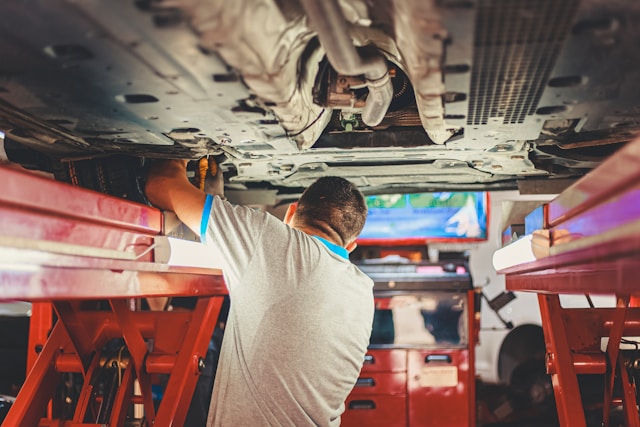Auto repair garages are quite profitable. Owners of auto repair garages earn as much as $137,500/year in the U.S. Their average salary is about $82,367.
Starting an auto repair garage is lucrative, but garages are prone to many hazards, such as fires and toxic fumes. These hazards pose a threat to the well-being of your workers.
Recently, a fire destroyed a garage in Litchfield while damaging two neighboring homes. In other news, a man was injured following an explosion that occurred in a garage in Sterling Heights, Michigan. The 70-year-old mechanic ingested a lot of smoke and suffered serious burns.
Accidents in garages are common. That is why you must take measures to ensure the safety of your workers. Here, we’ll discuss a few tips that will help you create a secure working environment for your garage workers.
#1 Ensure All Your Workers Wear Personal Protective Equipment
A garage is a dangerous place to work in. Personal protective equipment (PPE) can help protect your workers from safety hazards or potential injuries. Each employee must be equipped with it.
The Occupational Safety and Health Standards (OSHA) require employers to pay for the PPE of their employees. If someone gets hurt on the job because of a lack of PPE, you will be held liable.
Make sure each of your employees has safety goggles to protect against flying debris and chemicals and gloves to shield hands from cuts, burns, and chemical exposure. Go for nitrile and latex gloves. They are highly durable and provide better protection when handling fluids and chemicals.
You must also provide your workers with ear plugs or another ear protection device. It will protect them from loud noises. Go for ear protection with an NRR rating of 20dB or higher to protect your workers from noise-induced hearing loss. Steel-toed boots are also a must-have to protect against crushing injuries.
#2 Install a Vehicle Exhaust Extraction System
Garage workers are exposed to exhaust emissions. Vehicle exhaust emissions contain an array of harmful pollutants, including carbon monoxide and particulate matter. Exposure to these pollutants for extended periods can cause cardiovascular diseases, respiratory problems, and other negative health effects.
Wearing respirators can help limit exposure to these toxic substances. But, the OSHA notes that they might not be effective in providing protection if the amount exceeds the filter’s handling capacity.
Vehicle exhaust extraction systems can help eliminate this harmful emission from your garage. Hence, make sure you install one. Recommended vehicle exhaust extraction systems for auto shops range from overhead hose drops to reels. Go for exhaust hose reels, however.
These systems, Clean Air Company explains, are the most prevalent way to capture vehicle exhaust emissions in maintenance garages, protecting workers from the carcinogenic effects of diesel exhaust.
Exhaust hose reels are highly efficient in capturing and eliminating exhaust emissions from the garage. All you need to do is extend them to the length you want and connect them to the vehicle’s exhaust gas pipes. Once they vent vehicle exhaust fumes into the atmosphere, you can retract the hose reel.
#3 Enforce Safe Chemical Handling Practices
Your garage contains many chemical-based products. These include engine fluids, paint thinners, and industrial cleaners. Storing them safely isn’t enough; you must make sure these are handled carefully to protect workers from potential health hazards, such as respiratory issues as well as fires.
Train your employees on the safe storage, handling, and disposal of chemicals. Implement strict protocols for using chemicals, including measures to minimize exposure, such as working in well-ventilated areas and using appropriate PPE like gloves, goggles, and respirators.
Make sure all chemical containers are properly labeled and stored in areas away from heat sources and incompatible materials.
#4 Keep a Fire Extinguisher Handy
Garages are prone to fire. Your garage must have a fire extinguisher. Should there be a fire outbreak, your employees can use the fire extinguisher to put out the blaze before it escalates.
Choose a fire extinguisher rated for class A, B, and C fires. These are the common types of fires encountered in automotive settings. Blazes involving wood and cardboard are Class A fires. Class B fires involve flammable liquids such as petrol and paint, whereas Class C fires include flammable gasses such as butane.
Place extinguishers strategically throughout your garage in easily accessible locations. Also, make sure all employees know where they are as well as how to operate them.
To wrap things up, garages can be unsafe because they contain chemical and hazardous materials. As a garage owner, it’s your responsibility to ensure the safety of your workers. These tips will help you create a secure working environment and prevent accidents and injuries. A safe working environment will offer your workers peace of mind, ultimately boosting productivity.







